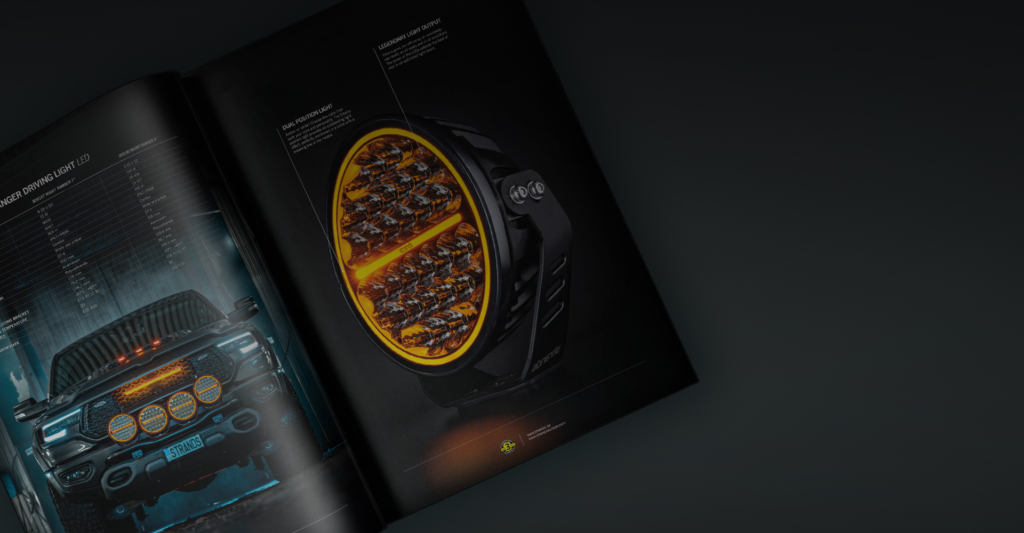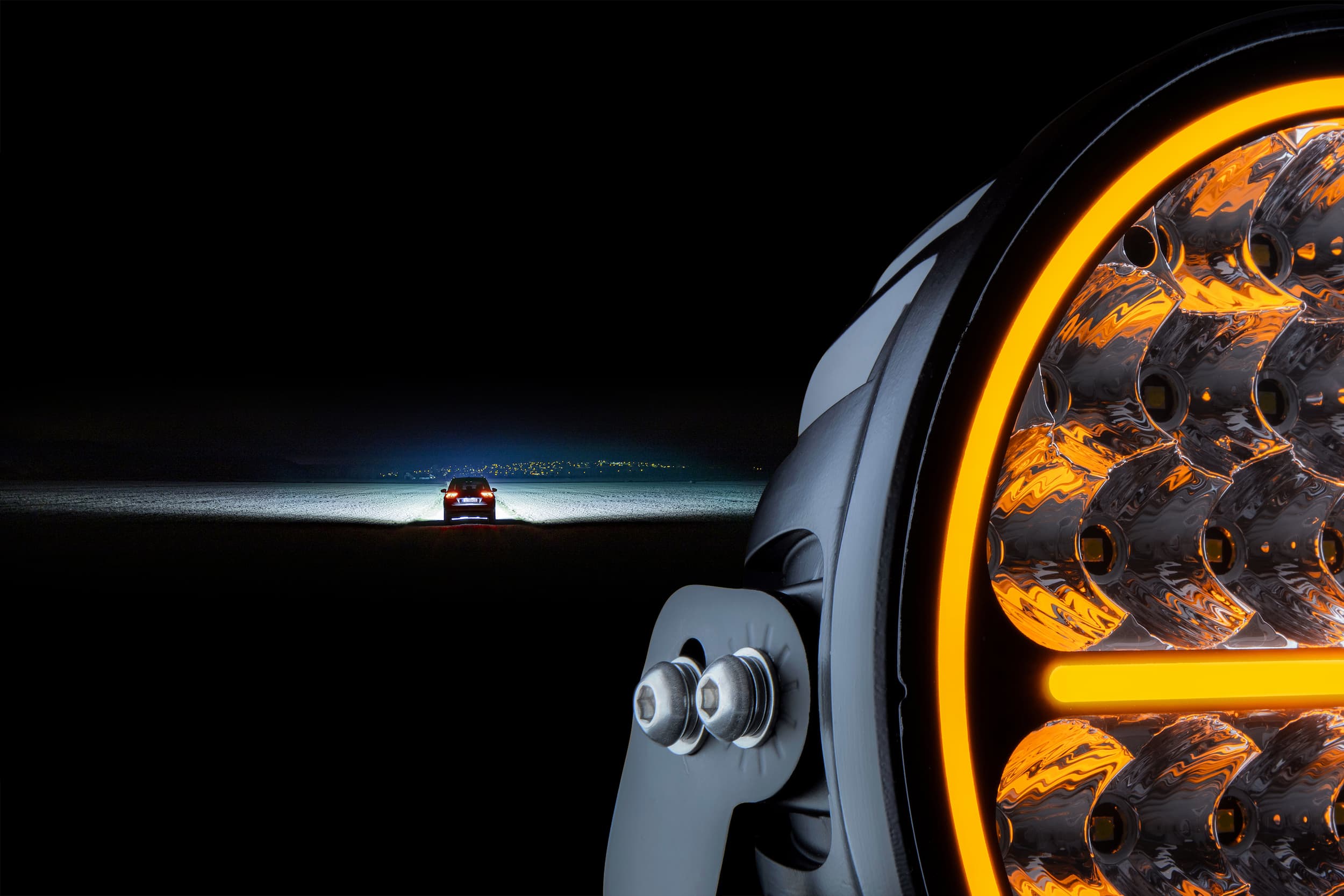
Choose the right driving light – the ultimate guide
Limited knowledge about driving lights but in need of more light? Don´t worry. Strands Lighting Division´s driving light guide gives you six key points that make navigating various models and designs easier.
There are driving lights that meet your specific design, performance, and functionality needs. No matter the roads you are driving on. Make your choice after looking at the following six points.
LIGHT TECHNOLOGY
The different light technologies differ in durability, lifetime, power, and price. Which of the technologies you prefer is a matter of taste – and what your application is.
Halogen – the traditional lighting technology that has long been the standard for the original passenger car lighting – is also used in driving lights. Provides a yellow-white light. The price is usually considerably lower than xenon and LED lights. Relatively short service life and sensitivity to external stresses can lead to frequent bulb changes.
Xenon – provides a bluish-white light similar to daylight. It may be perceived as less stressful to the eye than the yellow-white light of the halogen light. Less sensitive to shock and vibration than halogen lights. Long service life.
LED – the latest technology that is constantly growing. A maintenance-free choice with a very long service life where the burning time can exceed the life of your vehicle. Extremely resistant to external stresses and providing low energy consumption in relation to light. Short ignition time. Provides cool, white light close to daylight. The price is often higher than the halogen and xenon lights.

BEAM PATTERN
Before you choose the beam pattern – consider the roads you travel the most. You can mount lights with the same beam pattern or experiment with a combination to best meet your specific needs.
Flood. A wide pattern of light. It´s ideal for those driving on smaller, hilly roads and provides good light near and around the road.
Spot. A focused, long, and narrow beam pattern. Beneficial when combined with flood models. For example, a spot in the middle and two flood models on the sides may be the best solution for a passenger car. On trucks, a driving light with a spot model can be mounted on the roof, combined with the desired number of flood models in the grill.
Combo. A combination beam pattern with elements of both spot and flood. Great all-around light for those who drive everything from small country roads to long-distance driving on highways.
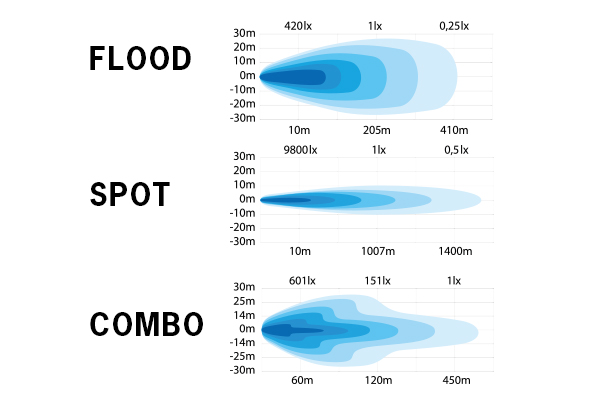
LIGHT OUTPUT
The light output provides the best results in combination with a good beam pattern – a total driving experience that shouldn´t be based only on lumen output and measured lux. The lux value is the most interesting to determine how far lamps illuminate.
Lumen. Measures the total light output from the driving light in all directions. The value doesn’t tell you how far it´s lit or the beam pattern.
Lux. The lux value is lumen per square meter, and one lux equals one lumen per square meter. Used to measure how much light reaches a specific area. A lux measurement doesn´t describe the design of a beam pattern – but is often considered to be the most exciting value to tell how far the driving light is lit.
Watts. Watts doesn´t necessarily describe the lamp´s performance – it´s only a measure of power consumption. If the lamp consumes 1 watt of power and provides excellent light, it´s better from an energy consumption point of view than it consumes 300 watts of power and delivers the same light.
IP RATING
The IP rating ensures how durable the driving light is against the external stresses of humidity, extreme heat changes, and dust. A driving light should meet at least IP67 – the higher the rating, the more durable light.
The following is an explanation of the different IP classes.
First digit (protection against live parts):
5 = dust protected
6 = dustproof
Second digit (water protection):
5 = protected against flushing water from the nozzle.
6 = protected against excessive water flushing.
7 = may be temporarily submerged in water without being damaged.
8 = suitable for prolonged water immersion.
9(K) = suitable for prolonged water immersion.
For example, IP66 – is dust-proof and protected against excessive water flushing.
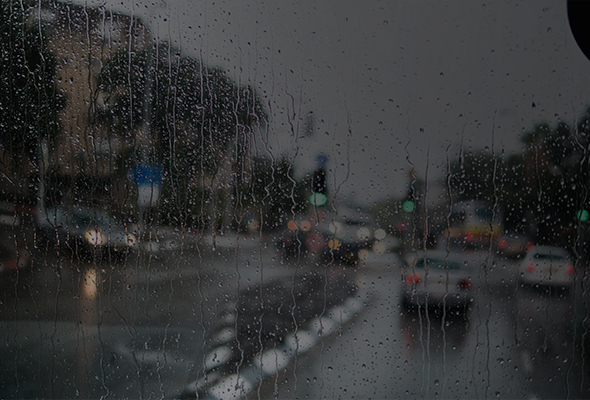
APPROVALS
If the driving light is E-approved, the light is approved for use in the EU. Approved driving lights have a mark consisting of a circle or square with an E and a number. The number refers to the country in which the light was approved but didn´t explain the purpose for which the light was approved.
A non-E-approved driving light may produce too much light. In practice, it´s rare for the traffic police to comment on the E-mark since Sweden doesn´t count reference numbers, and we can have as many driving lights as we want.
ECE marking. The E-approved use of the light is certified by the ECE marking, which for LED and halogen driving lights is ECE R112, and for xenon/HID driving lights is ECE R98.
Reference number. On all E-approved driving lights, there should be a given reference number. The reference number describes how a driving light is illuminated. According to the ECE Regulation, the total value of the main beam and driving light beam on a vehicle must not exceed 100 – in Sweden, however, there is no limit to this; only the main beam headlights must not exceed 100.
With two identical driving lights, the light with the highest reference number has a more extended range and a narrower beam pattern. Reference number 37,5 has been the most common in Sweden – but due to changes in the ECE regulation, it´s now possible to get a driving light with reference number 50 E-approved.
Radio interference/EMC. LED driving lights can affect vehicle electrical equipment and cause radio interference. If the light has an ECE R10 approval, the light is approved to be mounted on a vehicle. The approval certifies that electromagnetic radiation is within the regulatory framework.
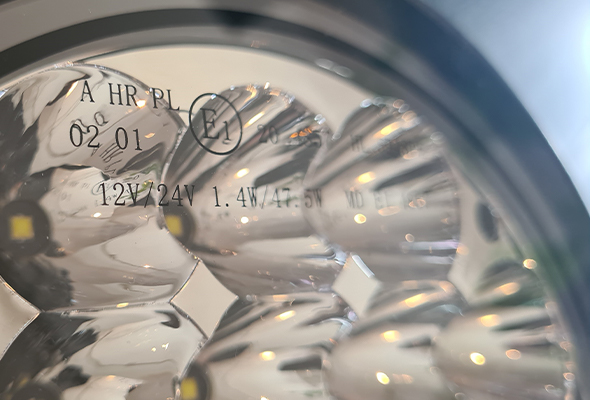
DESIGN
Really good driving lights are more than just high performance – they lift your vehicle’s look and reflect your taste. Today, there are a lot of options for creating the expression you want. Strands Lighting Division offers everything from driving lights with exclusive minimalist designs to models with explosive designs.
Position lights. The position light provides an appealing effect and can be designed in various ways. Several models from Strands Lighting Division come with a duo function – where the user chooses the position light´s color to suit their taste.
Optics. Optics play a significant role in appearance. Ambassador is an example of a driving light in a classic design with reflector technology, giving a pure expression. Siberia Night Ranger comes with many small reflectors and coppers that can look like eyes at night. Another example is models with optical lenses, which lie like a glass eye over the diode. All types have their advantages, and it’s your taste that matter.
Details. Small details are often crucial for a stylish light. For example, Strands Lighting Division has chosen to focus on lights with an infinity design – where the lens extends to the corners. It is a solution that makes a big difference to the overall impression and provides increased dirt resistance, making the lights more durable.
Shape and size. Looking for traditional round, oval – big or small? Or is it important that the lights are slim? Measure the space you have – and decide which one will be the best choice. Even the most compact models offer excellent light output, but generally, larger lights provide more light for your money.

ALSO, CHECK OUT ...
WARRANTY – does the driving light come with a warranty or not? A good indication of light quality. Strands Lighting Division’s driving lights come with a minimum three-year function warranty.
CANBUS – Does your vehicle need a Can-bus interface for the driving lights to work? The Can-bus interface listens for a high beam signal in the vehicle’s light warning system and then converts the signal into an analog plus signal that can be used with a separate wiring set. Learn more about Can-bus in Strands Lighting Divisions Can-bus school here.
THE LENS – does the driving light have a high-durability lens? The lens is usually made of tempered glass or polycarbonate plastic. Glass passes through much light – but a PC lens is unbreakable and is generally preferred. Strands Lighting Division uses a unique coating for PC lenses to further ensure quality.
